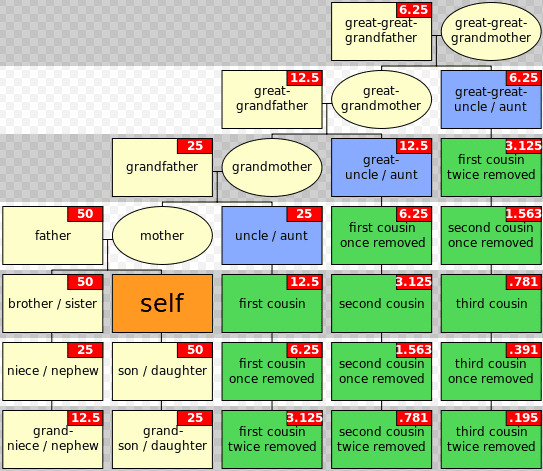Introduction: In this article – part of an ongoing “Introduction to Genealogy” series – Gena Philibert-Ortega explains a potentially confusing family relationship, cousins: first, second, removed, etc. Gena is a genealogist and author of the book “From the Family Kitchen.”
One day my cousin came over for a visit with his two young sons. He introduced me as “Aunt Gena.”
However, I’m not their aunt – because their father is my first cousin (to be more precise, he is my mother’s sister’s son) and not my brother. Because I’m a genealogist, of course, I had to correct him. He explained that he said I was their aunt because I was older than they were. However, that’s not how relationships work. Anyone who was born before their own aunt or uncle can attest to that.
I corrected him and explained that his sons and I were “first cousins once removed.”
He then gave me a questioning, perplexed look and asked: “What does ‘removed’ mean?”

Family Relationships
Historically, family relationships have been confusing. It’s not unusual to find that an ancestor referred to someone as a cousin when they really weren’t. Just think about your own life. Do you ever refer to a good friend as a “sister” or a “brother”? I’ve had friends’ children refer to me as their “aunt” because they felt like I was “family.” Familial relationships are just plain confusing, even when correctly identified.
An Oxford Dictionaries blog post titled “What is a second cousin?” points out that “English is sometimes irritatingly vague when it comes to kinship terminology, even within fairly close family relationships. I can’t tell (without more context) if your brother-in-law is your sister’s husband or your husband’s brother.”* Another example: referring to someone as your “aunt” could mean your father’s or mother’s sister. You can see how English lets us down in describing those we are related to!
For family historians who work on connecting generations through parental-child relationships, identifying relationships correctly is important. Especially in today’s world when your DNA results provide you with relationship estimates that include cousins.
When attempting to figure out a familial relationship ask yourself: “Who is the most recent common ancestor?” This will help you determine your relationship to another person. So, for example, siblings share parents, and cousins (the children of siblings) share a common set of grandparents.
Cousins
Now, about that term “cousin.” What is a cousin? As mentioned above, they are the children of siblings, or the child of one’s aunt or uncle. It’s probably important to think of a first cousin as someone you share a set of grandparents with. That goes back to the idea of who is the most common recent ancestor.
As an example, my son and my brother’s son are cousins and they share a common set of grandparents (my and my brother’s parents).
“Removed”
Now, let’s mix things up a bit. If my son were to have a girl, what would that child’s relationship be to my son’s first cousin – who is my brother’s son?
Well, the relationship of that newest addition (my granddaughter) to my brother’s son (my nephew) would be a first cousin once removed. Why? Because compared to my nephew, my granddaughter would be an additional generation removed from the common ancestor. Meaning that there is a generation separating these two people: my parents are the grandparents to my nephew but the great-grandparents to my son’s child.
So, what about this term “removed?” What in the world does that mean? It has to do with what generation they are from the common ancestor. Now, make sure you don’t equate the word “generation” with “age.” And don’t assume because someone is not your “first cousin” that they are automatically your “second cousin.”
First Cousin Once Removed vs. Second Cousin
Which leads me to the question: Who is your second cousin? Once again, we look at who the common ancestor is. Second cousins share a pair of great-grandparents. If my son and my nephew had children, those children would be each other’s second cousins.
Alternatively, if we look at it the opposite way, your mom’s first cousin’s child would be your second cousin. Or if your grandfather had a brother with grandchildren, they would also be your second cousins.
We can appreciate that this first cousin vs. second cousin debate is complicated, and answers to “What relation is your cousin’s child?” can be challenging to grasp if this is your first time exploring your family tree.
But now that we’ve discussed what is a first cousin and what constitutes a second cousin, what would be your second cousin once removed?
As we’ve discussed, a cousin once removed originates from a generation above or below where you sit on the family tree. In the case of your 1st cousin once removed, this is the child of your first cousin or the first cousin of your parents.
If you have a second cousin once removed, the same principle applies. This is the child of your second cousin or the second cousin of your parents. Even genealogists with decades of experience often have to refer to a relationship chart to remember how it works – and I’m no exception.
But once you’ve grasped the basic meaning of what a 1st cousin once removed is, you can apply the same cousin once removed meaning to every other generation. With this in mind, what would a second cousin twice removed be?
All that twice removed means is that there’s a gap of two generations. A cousin twice removed would come from your grandparents’ or grandchild’s generation instead of your parent’s or child’s.
And this continues on and on.
What is a Third Cousin?
I often find that some of the most intriguing connections come from digging deeper into your extended family. You uncover some amazing finds within your family tree when you go beyond first and second cousins.
For example, did you know that the Democratic Party’s Senate leader Chuck Schumer is the first cousin once removed of comedian Amy Schumer? Or that genealogist William Addams Reitwiesner found that Angelina Jolie and Madonna are both distant relations of Hillary Clinton?
During his research, he found that Madonna is Clinton’s 10th cousin and Jolie is Clinton’s 9th cousin twice removed.
Not all of us can hope to find such famous faces in our family trees, but you might be surprised. To put it simply, third cousins are two people with identical great-great-grandparents. If you’ve got a third cousin, this is the great-grandchild of your mom’s great-aunt.
Genealogy Hack
Comparing a first cousin once removed and a second cousin isn’t straightforward. Still, we’ve got a hack within genealogy circles to help you untangle everything when you create your personal family tree.
Simply put, the number of your cousin plus one corresponds to the number of generations out from your shared ancestor.
So, first cousins are the second generation removed from their shared grandparents. Second cousins are the third generation removed from their shared grandparents. Third cousins are the fourth generation removed from their shared grandparents. This is one rule that always stays the same. So, just follow the numbers if you don’t have a relationship chart on hand.
FAQs
What is my mom’s cousin to me?
Your mom’s cousin is your first cousin once removed. Remember, you don’t share the same grandparents, but you do share the same great-grandparents. This generational difference is what makes them your first cousin once removed.
But if your mom’s cousin has a child, that child would be your second cousin. However, while you might be tempted to refer to them as your second cousin once removed, this would be incorrect. You share the same great-grandparents, meaning that there would be no “removed” added for the child.
What is my cousin to my child?
Your children would be the second cousins of your cousin’s children. However, when your first cousin has a grandchild, they would be your first cousin twice removed because there’s a two-generation gap.
What is my cousin’s child to me?
One of the biggest misconceptions in genealogy is that your cousin’s child would be your second cousin. After all, it makes sense that if your first cousin starts a family, the next generation would translate to your second cousin; hence, their grandchildren would be your third cousins.
However, this is not the case. They are also your first cousin, but they are considered to be once removed. In plain English, these are your nieces and nephews. Few people will refer to a niece or nephew as their first cousin once removed, but this is technically what they are.
What is my cousin’s grandchild to me?
Your cousin’s grandchild is not your third cousin, as the distance between your common ancestors hasn’t changed. Instead, your great-nieces and nephews would be your first cousins twice removed.
How many generations until I’m no longer related?
Cousins are an exciting proposition because even though you share ancestors, there’s always a point where you are no longer considered closely related.
Legally, you may no longer be considered kin as a second, third, or fourth cousin. However, experts believe eliminating shared DNA takes five to six generations. So, if you’ve got a 10th cousin, even though you have shared ancestors, most people would barely consider you related.
While this may seem unfair, technically speaking, most people are related if they go back far enough through the generations. For genealogical purposes, it’s still well worth researching as far back as possible to uncover different categories of ancestors using tools like GenealogyBank.
How much DNA do I share with my cousins?
If you’re curious about how much DNA you share with your first cousin once removed, or cousins further removed, this can be worked out with some basic math. A first cousin will share 12.5% of their DNA. If your cousin is once removed, this is halved to 6.25% because there’s an extra generation of separation.
Second cousins share 3.13% of DNA, whereas a second cousin once removed shares just 1.5% of their DNA. By the time you reach the fifth cousin, they will share just 0.05% of DNA, with a fifth cousin once removed sharing half that.
Figuring It Out
You can find several different types of relationship charts online, including this one from GenealogyInTime Magazine, which help make it easier to determine your relationship between two people. If you are using a genealogy software program, most include a relationship calculator that can also help.
When analyzing your DNA results you may need to go beyond the relationship estimates provided by your testing company. Consider using the Genetic Genealogist’s Shared cM Project Tool.
* “What is a second cousin? and other cousin questions ,” Oxford Dictionaries (https://blog.oxforddictionaries.com/2013/08/30/naming-of-cousins/: accessed 21 January 2018).
Related Article:
